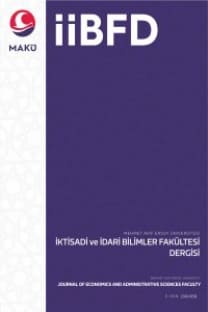REÇETE EDİLEN ANTİBİYOTİK VE İLAÇ KULLANIMININ SOSYOEKONOMİK BELİRLEYİCİLERİ VE AİLE HEKİMLİĞİ İLE İLİŞKİSİ
Reçete edilmiş antibiyotik kullanımı, reçete edilmiş ilaç kullanımı, aile hekimliği, sosyoekonomik belirleyenler
SOCIOECONOMIC DETERMINANTS OF PRESCRIPTION ANTIBIOTIC AND MEDICINE USE AND ITS RELATIONSHIP WITH FAMILY MEDICINE
Prescribed antibiotics utilization, prescribed medicine utilization, family medicine, socioeconomic determinants,
___
- AKDAĞ, R. (2011), Turkey health transformation program assessment report (2003-2011). Retrieved October.10:2014.
- ALTUNSOY, A., AYPAK, C., AZAP, A., ERGÖNÜL, Ö., & BALIK, İ. (2011) The impact of a nationwide antibiotic restriction program on antibiotic usage and resistance against nosocomial pathogens in Turkey. International journal of medical sciences, 8(4), 339. doi.org/10.7150/ijms.8.339
- ATUN, R., AYDIN, S., CHAKRABORTY, S., SÜMER, S., ARAN, M., GÜROL, I., NAZLIOĞLU, S., OZGÜLCÜ, S., AYDOĞAN, U., AYAR, B., DİLMEN, U., & AKDAĞ, R. (2013). Universal health coverage in Turkey: enhancement of equity. Lancet (London, England), 382(9886), 65–99. doi.org/10.1016/S0140-6736(13)61051-X
- AYDIN, B., ve GELAL, A. (2012). Akılcı İlaç Kullanımı: Yaygınlaştırılması ve Tıp Eğitiminin Rolü. DEÜ Tıp Fakültesi Dergisi, 26 (1): 57-63. COVVEY, J. R., JOHNSON, B. F., ELLIOTT, V., MALCOLM, W., & MULLEN, A. B. (2014). An association between socioeconomic deprivation and primary care antibiotic prescribing in Scotland. The Journal of antimicrobial chemotherapy, 69(3), 835–841. https://doi.org/10.1093/jac/dkt439
- DEVRİM, İ., GÜLFİDAN, G., ORUÇ, Y., YAŞAR, N., SORGUÇ, Y., AYHAN, F.Y., BAYRAM, N., & ÜNAL, N. (2009) Point-Prevalence Study Relating to Antibiotic Usage in Dr. Behçet Uz Children Hospital; Comparison of 2008 and 2012 Data. Journal of Pediatric Infection/Cocuk Enfeksiyon Dergisi. 3(1). doi:10.5152/ced.2012.11
- ERTUĞRUL, M.B., ÖZGÜN, H., SAYLAK, M.Ö., & SAYIM, N. (2009) Antibiotic Use and Its Cost in Surgical Clinics of a University Hospital: A One-Day Point Prevalence Survey. Klimik Dergisi. 22(2):44-7. doi.org/10.24938/kutfd.490693
- FILIPPINI, M., MASIERO, G., & MOSCHETTI, K. (2006). Socioeconomic determinants of regional differences in outpatient antibiotic consumption: evidence from Switzerland. Health policy (Amsterdam, Netherlands), 78(1), 77–92. doi.org/10.1016/j.healthpol.2005.09.009
- IEIS. Turkish Pharmaceutical Market, 2018. Accessed on 1st May, 2020 http://ieis.org.tr/ieis/assets/front/sektorraporu2018/Turkish_Pharmaceutical_Market_2018.pdf
- ILHAN, M. N., DURUKAN, E., ILHAN, S. O., AKSAKAL, F. N., OZKAN, S., & BUMIN, M. A. (2009). Self-medication with antibiotics: questionnaire survey among primary care center attendants. Pharmacoepidemiology and drug safety, 18(12), 1150–1157. doi.org/10.1002/pds.1829
- KARABAY, O., & HOSOGLU, S. (2008). Increased antimicrobial consumption following reimbursement reform in Turkey. The Journal of antimicrobial chemotherapy, 61(5), 1169–1171. doi.org/10.1093/jac/dkn055
- KARABAY, O., ÖZDEMİR, D., GÜÇLÜ, E., YILDIRIM, M., İNCE, N., KÜÇÜKBAYRAK, A., ÇAKIR, S., GÜLENÇ, M., İNCE, M., & DEMİRLİ, K. (2011). Attitudes and behaviors of Family Physicians regarding use of antibiotics. Journal of Microbiology and Infectious Diseases.1(02),53-57. DOI: 10.5799/ahinjs.02.2011.02.0013
- MARRA, F., MAK, S., CHONG, M., & PATRICK, D. M. (2010). The relationship among antibiotic consumption, socioeconomic factors and climatic conditions. The Canadian journal of infectious diseases & medical microbiology = Journal canadien des maladies infectieuses et de la microbiologie medicale, 21(3), e99–e106. doi.org/10.1155/2010/965268
- McGOWAN, J. E. (2001). Economic Impact of Antimicrobial Resistance. Emerging Infectious Diseases, 7(2), 286-292. doi.org/10.3201/eid0702.700286.
- MOLLAHALİLOĞLU, S., ALKAN, A., DÖNERTAŞ, B., OZGULCU, S., & AKICI, A. (2013). Assessment of antibiotic prescribing at different hospitals and primary health care facilities. Saudi pharmaceutical journal: SPJ: the official publication of the Saudi Pharmaceutical Society, 21(3), 281–291. doi.org/10.1016/j.jsps.2012.10.004
- ÖZKURT, Z., EROL, S., KANADALI, A., ERTEK, M., ÖZDEN, K., & TAŞYARAN, M.A. (2005). Changes in antibiotic use, cost and consumption after an antibiotic restriction policy applied by infectious disease specialists. Japanese journal of infectious diseases.58(6):338.
- ÖZTÜRK, S., BAŞAR, D., ÖZEN, İ. C., & ÇİFTÇİ, A. Ö. (2019). Socio-economic and behavioral determinants of prescription and non-prescription medicine use: the case of Turkey. Daru: journal of Faculty of Pharmacy, Tehran University of Medical Sciences, 27(2), 735–742. doi.org/10.1007/s40199-019-00311-1
- PARLAK, E., ÇAYIR, Y., & ERTÜRK, A. (2013). Rational Antibiotic Use Among Family Physicians: A Cross-Sectional Study from Erzurum. Euras J Fam Med.2(1):27-32.
- SABA, R., İNAN, D., TURHAN, Ö., YALÇIN, A.N., GÜLSEREN, F., & MAMİKOĞLU, L. (2011) Surveillance of antimicrobial use in a Turkish university hospital. Turkish Journal of Medical Sciences. 41(4):701-10. DOI: 10.3906/sag-1005-812
- SAĞIR, M. & PARLAKPINAR, H. (2014). Rational Use of Medicaments. İnönü Üniversitesi Sağlık Bilimleri Dergisi. 3(2):32-5.
- STOKES, J., GUROL-URGANCI, I., HONE, T., & ATUN, R. (2015). Effect of health system reforms in Turkey on user satisfaction. Journal of global health, 5(2), 020403. doi.org/10.7189/jogh.05.020403
- TEPAV. (2017) Türkiye'de Antibiyotik Direnç: Ekonomik Değerlendirme ve Öneriler. Accessed on 1st May, 2020, https://www.tepav.org.tr/upload/files/1504774735-1.Turkiye___de_Antimikrobiyal_Direnc___Ekonomik_Degerlendirme_ve_Oneriler.pdf
- TERNHAG, A., GRÜNEWALD, M., NAUCLER, P., & WISELL, K. T. (2014). Antibiotic consumption in relation to socio-demographic factors, co-morbidity, and accessibility of primary health care. Scandinavian journal of infectious diseases, 46(12), 888–896. doi.org/10.3109/00365548.2014.954264
- TİRGİL, A., GUROL-URGANCI, I. & ATUN, R. (2018). Early experience of universal health coverage in Turkey on access to health services for the poor: regression kink design analysis. Journal of global health, 8(2), 020412. doi.org/10.7189/jogh.08.020412
- WORLD HEALTH ORGANIZATION. (2015), Global action plan on antimicrobial resistance. accessed on 1st May, 2020, https://apps.who.int/iris/bitstream/handle/10665/193736/9789241509763_eng.pdf?sequence=1
- YILMAZ, G., BULUT, C., YILDIZ, F. (2009). Examining Antibiotic Use at an Education and Research Hospital in Turkey: Point Prevalence Results. Turkish Journal of Medical Sciences, 39(1), 125-131.
- ISSN: 2149-1658
- Yayın Aralığı: Yılda 3 Sayı
- Yayıncı: Mehmet Akif Ersoy Üniversitesi İktisadi ve İdari Bilimler Fakültesi
İNDİRİM DÜZEYLERİ VE SOSYAL SINIFLAR AÇISINDAN TÜKETİCİ FİYAT ALGISINDAKİ FARKLILIKLARIN İNCELENMESİ
Kalender Özcan ATILGAN, Onur KOÇ
FAST FOOD ÜRÜN TERCİHLERİNDE OYUNCAK ETKİSİ
Sabiha KILIÇ, Kübra Müge ÇAKARÖZ, Leyla BEZGİN EDİŞ
TÜRKİYE’DE HANEHALKLARININ BALIK TÜKETİM HARCAMALARI: LOGIT VE MULTINOMIAL LOGIT YAKLAŞIMLARI
Onur DEMİREL, Selim Adem HATIRLI
İŞLETMELERDE DEĞER TEMELLİ YÖNETİM UYGULAMALARI: TÜRKİYE İÇİN BİR MODEL ÇALIŞMASI
Gürcan PAPATYA, Nurhan PAPATYA
KALKINMA AJANSLARININ KURUMSAL SORUNLARI VE ÇÖZÜMLERİNE İLİŞKİN AMPİRİK ANALİZ: TÜRKİYE ÖRNEĞİ
İ̇hsan KURAN, Yüksel BAYRAKTAR
İSLAM ÜLKELERİNDE EKONOMİK ÖZGÜRLÜĞÜN GİRİŞİMCİLİK ÜZERİNDEKİ ETKİSİ
KAMU MALİ YÖNETİMİ KAPSAMINDA ÇOK DEĞİŞKENLİ GRİ TAHMİN MODELİ İLE VERGİ GELİRLERİ TAHMİNİ
